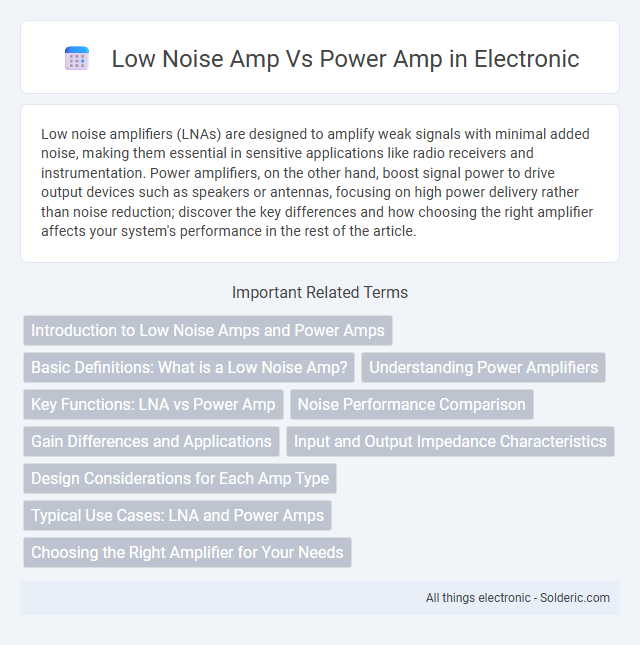Low noise amplifiers (LNAs) are designed to amplify weak signals with minimal added noise, making them essential in sensitive applications like radio receivers and instrumentation. Power amplifiers, on the other hand, boost signal power to drive output devices such as speakers or antennas, focusing on high power delivery rather than noise reduction; discover the key differences and how choosing the right amplifier affects your system's performance in the rest of the article.
Comparison Table
| Feature | Low Noise Amplifier (LNA) | Power Amplifier (PA) |
|---|---|---|
| Primary Function | Amplifies weak signals with minimal added noise | Boosts signal power for transmission or driving loads |
| Noise Figure | Very low (1-2 dB typical) to preserve signal integrity | Higher noise figure acceptable, focus on power output |
| Gain | Moderate gain (10-20 dB typical) | High gain or high power output depending on application |
| Output Power | Low output power (milliwatts range) | High output power (watts to kilowatts range) |
| Applications | RF receivers, front-end amplification, signal detection | Transmitters, RF power delivery, driving antennas or speakers |
| Linearity | Moderate linearity to maintain signal fidelity | High linearity critical for high-power signals, depends on class |
| Power Consumption | Low power consumption | High power consumption |
| Design Focus | Minimize noise figure and input losses | Maximize efficiency and output power |
Introduction to Low Noise Amps and Power Amps
Low noise amplifiers (LNAs) are designed to amplify weak signals with minimal added noise, crucial in applications like radio receivers and sensitive measurement systems. Power amplifiers (PAs) focus on increasing signal power to drive loads such as speakers or antennas, emphasizing output power and efficiency over noise performance. Understanding the specific function and design priorities of LNAs versus power amps is essential for optimizing signal integrity and system performance in various electronic applications.
Basic Definitions: What is a Low Noise Amp?
A low noise amplifier (LNA) is a specialized electronic amplifier designed to amplify weak signals while minimizing added noise, thereby preserving signal integrity in communication systems. Unlike power amplifiers, which focus on increasing signal power for transmission over long distances, LNAs prioritize signal clarity and sensitivity, especially in radio frequency (RF) and audio applications. Your system's overall performance depends heavily on the LNA's ability to boost tiny incoming signals without degrading quality.
Understanding Power Amplifiers
Power amplifiers increase the signal's power to drive speakers effectively, producing higher output volume essential for audio systems. Low noise amplifiers (LNAs) prioritize minimal internal noise to preserve signal clarity, typically boosting weak signals before power amplification. Understanding power amplifiers helps optimize your audio setup by balancing volume needs with signal fidelity for clear, powerful sound.
Key Functions: LNA vs Power Amp
Low Noise Amplifiers (LNAs) primarily amplify weak signals with minimal added noise, enhancing signal quality in the early stages of reception. Power Amplifiers (PAs) boost the signal power to drive output devices or antennas, ensuring strong transmission and coverage. Your system's performance depends on using LNAs for sensitivity and PAs for signal strength amplification.
Noise Performance Comparison
Low noise amplifiers (LNAs) are specifically designed to minimize noise figure, making them ideal for boosting weak signals without significant degradation. Power amplifiers prioritize output power over noise performance, often introducing higher noise levels due to increased gain and non-linearities. Your choice depends on whether preserving signal clarity or maximizing power output is more critical for your application.
Gain Differences and Applications
Low noise amplifiers (LNAs) are designed to provide high gain with minimal added noise, making them ideal for sensitive signal front-end applications such as radio receivers and medical devices. Power amplifiers prioritize delivering high output power with moderate gain, targeting applications like wireless transmission and audio amplification where signal strength is critical. Understanding gain differences helps you choose an amplifier that balances noise performance with output power suitable for your specific application.
Input and Output Impedance Characteristics
Low noise amplifiers (LNAs) typically feature high input impedance, minimizing signal loss and preserving signal integrity from sources like antennas or sensors. Power amplifiers (PAs), in contrast, have low output impedance to efficiently drive low-impedance loads such as speakers or transmission lines, ensuring maximum power transfer. The complementary impedance characteristics optimize signal chain performance by reducing noise at the input stage and maximizing power delivery at the output stage.
Design Considerations for Each Amp Type
Low noise amplifiers (LNAs) prioritize minimizing input-referred noise and maintaining high linearity to preserve signal integrity in weak signal environments, often employing low-noise transistors and optimized impedance matching. Power amplifiers (PAs) focus on maximizing output power and efficiency, requiring robust thermal management and distortion control through methods like Doherty or Class AB designs. Your amplifier choice depends on balancing noise performance with power delivery requirements dictated by the application.
Typical Use Cases: LNA and Power Amps
Low noise amplifiers (LNAs) are typically used in front-end RF circuits to amplify weak signals with minimal added noise, making them crucial in applications like satellite communications, radio telescopes, and wireless receivers where signal integrity is paramount. Power amplifiers (PAs) are designed to increase signal power to drive antennas or other load components, commonly found in transmitters for cellular base stations, broadcasting, and Wi-Fi routers to ensure strong signal transmission over larger distances. Your choice between an LNA and power amp depends on whether the priority is enhancing signal reception quality or maximizing transmission power.
Choosing the Right Amplifier for Your Needs
Low noise amps excel at minimizing signal distortion, making them ideal for sensitive audio equipment and precise sound reproduction. Power amps provide higher wattage output to drive speakers efficiently, perfect for live performances or large venues demanding robust sound levels. Choosing the right amplifier depends on whether your priority is clarity and fidelity or sheer output power for your audio setup.
low noise amp vs power amp Infographic

 solderic.com
solderic.com